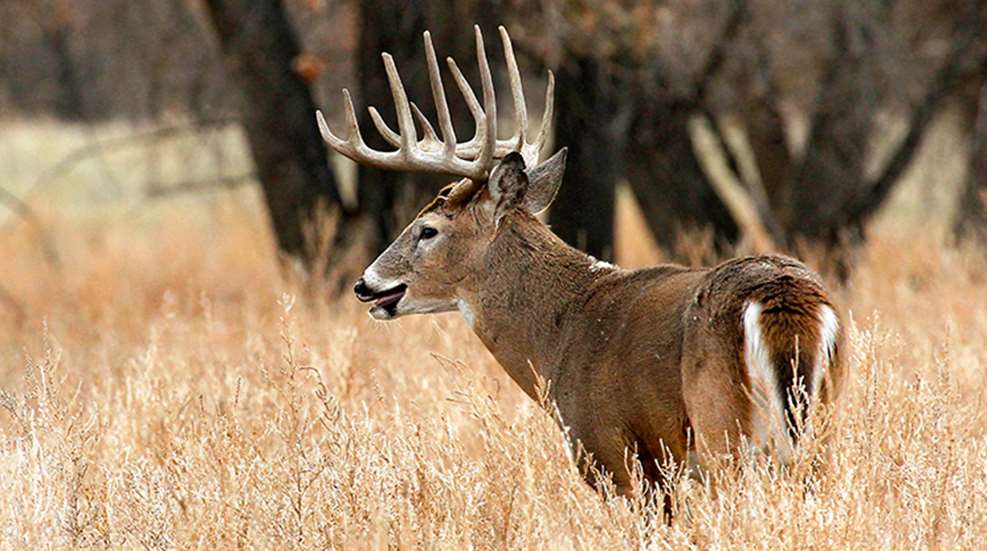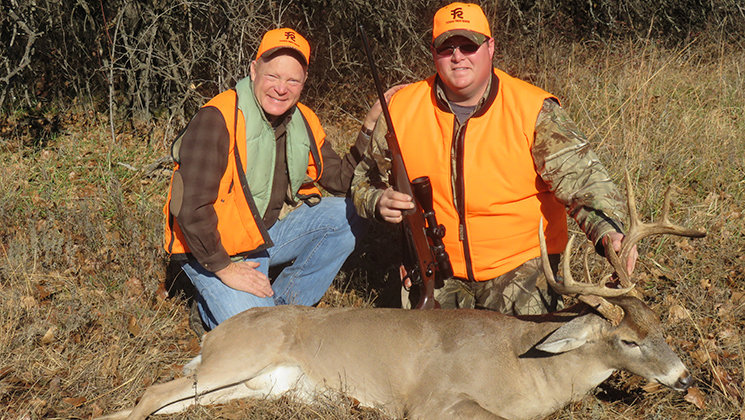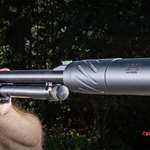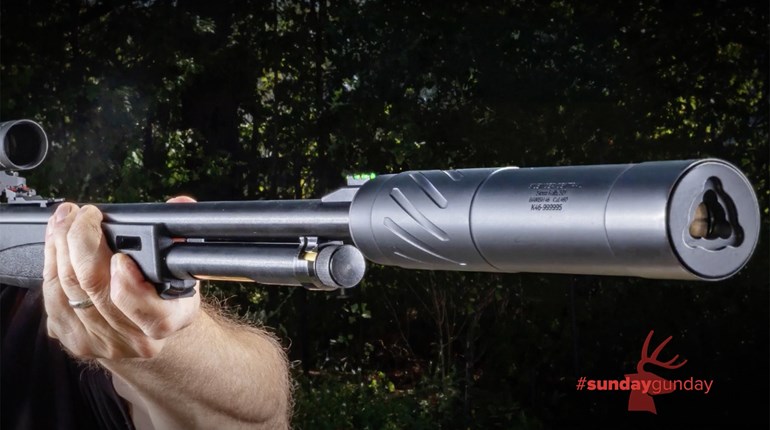
Dark was falling fast when the shot jarred me. In our rolling oak ridges, we’ve learned it’s impossible to tell exactly where a shot came from, but it wasn’t far and I had hopes. Then my cell phone rang. “Got a buck, looks like a good one. It’s just under my stand!”
That was good news but not enough information. Not meaning to be a wet blanket, I said, “Congrats … but who is speaking, and where are you?”
Shocked pause, then: “Oh, this is Max, I’m at the Valley Stand.” Breathing hard and accelerating, he added, “It’s a really nice buck. He came across the creek just at dark, stopped when I raised the rifle, and … ”
Yes, it was a nice buck, a heavy-racked 9-pointer, taken by Max Monbouquette, in his early 20s, out of college and working his first job. He’d done some pig and deer hunting and was a really nice young guy, extremely keen. I knew this was his first whitetail … but I didn’t know this was his first buck. No wonder he was excited; so was I.
Home-Place Whitetails
During a long career I’ve been extremely fortunate to do a lot of the stuff we all love to do, but just like 10 million other American hunters I get more excited about deer hunting than anything. I have a small piece of southeast Kansas dirt that serves as my whitetail university, except the deer are the teachers, and I’m a pretty dumb student.
In other parts of the country, Kansas is often viewed as the Promised Land for big bucks. Indeed it’s good, with a high buck-to-doe ratio maintained by a one-buck limit and aided by a short post-rut rifle season. But there aren’t Boone and Crockett bucks behind every bush—at least not at my place! My area is not the Great Plains, and there are no Yellow Brick Roads. We have thick oak ridges, not much different from southern Missouri and Arkansas. It’s heavy timber with limited agriculture; it is not easy whitetail hunting.
I’ve had this farm for eight years; the last few seasons neighbor Chuck Herbel and I have pooled our properties and run a (very) small “guided operation.” This has steepened my learning curve, but it hasn’t done much for my own deer hunting. We do okay, but we are not a “100 percent” area. The timber is too thick, and the post-rut rifle season is too fickle. Actually, I shouldn’t complain: I’ve taken a buck every year, but I have the whole season so I can bowhunt early when I wish to, and during rifle season I slip out when I can. None have been the Midwest monsters we dream of, but that means they’re still there in the woods!
 Ooops!
Ooops!
Just when I think I have things figured the deer throw me a curve. I have a stand up on an oak-covered ridge, one of the original spots. My first morning on that stand I watched a procession of 14 bucks from small to large, some right under the stand. A buddy was on the next ridge, and I didn’t want to shoot until he got a buck, so I didn’t. And although I’ve sat there many times since, to this day no deer have been taken from that stand. The issue is food sources. We had acorns then, but we had five dry years with no acorns. The last two years have been better.
It was in 2013 when Chuck and I discovered Max’s “Valley Stand.” Acorns were spotty, but down below the Ridge Stand we found a pocket. Better, it wasn’t far from my major food plot, and the trails were like highways. We figured it a “staging area” where deer might pause before going to the food plot after dark. With an archery hunt coming on, we put in a stand.
I put a guy there his first evening … and he saw nothing. The next evening I wanted him back there but he preferred his morning spot (where he’d seen deer). Well, the customer is always right and, after all, to some extent whitetail hunting is a crapshoot. So I put him out, and I went back to the house and started to write a story. Then it occurred to me that it was my birthday (never mind which one). I shouldn’t be working. So I went down to the Valley Stand. That was my second mistake. The third was taking the bow. I hadn’t been there a half-hour before I arrowed the best buck I’ve taken on the place. My first mistake: Well, I should have been more insistent. I believed the Valley Stand would produce, I just didn’t know when.
Same Deer, Different Year
I’m still learning. I will never be an expert whitetail hunter, if there is such a thing. One of the things I have learned is that every year is different.
Archery season doesn’t change much, at least in terms of deer activity. Halloween sees a lot of rubbing and scraping, with the peak hitting somewhere in mid-November.
Rifle season starts on the Wednesday after Thanksgiving. We hope for a rut that kicks off late or stretches out a bit. Opening day is usually pretty crazy. Then deer movement tapers off and things get tougher. Toward the end movement usually picks up, often with some secondary rut activity. But it depends heavily on the weather.
Rifle Season 2014
One word: Tough! Daughter Caroline and I bowhunted Thanksgiving weekend, and although we blanked out, we had bucks chasing, cruising, scraping everywhere! Four days ’til rifle season, looking good! Then a major cold front came through and the rut shut down. There was residual activity in the woods, but the visible chasing never resumed. Movement got a bit better at the end of the season, but I wasn’t surprised. We aren’t far from Oklahoma so, technically, our deer are probably the texanus subspecies, not the macrourus race of northern and western Kansas. I’ve seen this too often: Cold weather shuts them down, and in 2014 a visibly active rut never resumed.
There were two other major factors, one clearly against us, the other neutral depending on how you deal with it. At the start of the season the moon was already bright and coming full. Since the season is fixed, there is nothing to be done about that but accept that a full moon reduces daytime movement. We got good rains, so through the summer we recognized that we were going to have the best acorn crop in five years. Our whitetails love their acorns, so I expected most movement to be in the woods. This isn’t necessarily bad, but it would mean that our feeders were useless, clearings and food plots not much better.
This was predictable, but movement in the latter part of archery season fooled me. Feeders were mostly ignored, but until that cold front hit we saw lots of deer cruising open areas, including several bucks I’d never seen before. I knew that weather change would slow things, but it took precious days to appreciate the full impact. A cool and cloudy opening day came in absolute, eerie silence, no shots anywhere.
This was unprecedented and depressing, and it continued to the weekend. Our hunters saw a few bucks. Most were small and consciously passed, which is good. A couple of nice bucks slipped past without offering a clean shot, which is not good but happens. We also had a couple of failures to thread the needle, which is a nice way to say that, er, trees were hit instead of the bucks moving through said trees. In timber hunting this also happens. But, Lord, it was the morning of the third day before the first buck was taken!
This one, a clean 10-pointer, cut across the corner of my major food plot and my old friend Ed Segar pasted him. To some extent this signaled the end of what had been at least a 96-hour shut-down. That evening before sundown Paul Cestoni flattened a high-racked, mature 8-pointer, also cutting across an open area on Chuck’s place.
Into the Woods
Despite these two successes in “normal” areas it was pretty clear what was happening: The deer were in the woods, scarfing down our record mast crop. This is not a major problem. We have stands covering our feeders and food plots, but the majority of our country is oak woods. So the majority of our stands are in the woods, overlooking key trails, and rub and scrape lines. Some of these are repeated year after year, but every year we find something new and interesting, so we move unproductive stands or add new ones. Several stands have produced bucks in multiple years: Old Box, Hagen, Rimrock, Spencer, Taj … now Valley. We have others that have produced multiple bucks in one season, like House and Pecan Grove. And we have others that I judge to be as good or better, but from which no bucks have been taken. One of these is my favorite Ridge Stand, which blows so hot and cold it must be bipolar.
Even with the best planning, scouting and stand-sitting, hunting whitetails in timber is somewhat random … and rarely easy. Wind and movement will mess up things, and often you aren’t even aware that you’ve been messed up. Despite the best planning and most astute reading of sign, whitetails move as they will, so a right-handed shot becomes a left-handed shot, or a deer comes from directly behind and you never know until you hear the alarm snort: Game over!
It’s not easy to sit still, and I’d be the first to say that I hate it—but we don’t have options. Carpeted with dry leaves, our woods are just too noisy for still-hunting. If, just once, we got a foot of fresh snow during the season I fantasize that we could creep into Bucky’s bedroom. Maybe we could, but in eight years only the lightest skiff of snow has fallen during rifle season. After a few days of fruitless sitting someone always asks about organizing drives. Uh, we’ve tried that. We can stir up deer and send them to the neighbors, but our woods are too big, with too many escape routes and too few channelizing features.
What we should do—some of our hunters do it but I simply cannot—is sit longer, and most especially in the timber. In the deep woods there’s a fair amount of midday movement. I think this is especially common when the moon is bright. You can’t do anything about nocturnal movement—but the deer aren’t likely to stay bedded in one place all day. No matter the moon, the woods are sanctuary, and there will be midday movement. This may be especially true during deer season; it doesn’t take deer long to figure out that at dawn and dusk the woods are full of bad-smelling pumpkin-clad creatures, while during the midday hours things are quieter.
On the last day of the season, Sunday, young Max (he of the big 9-pointer) still wanted to fill his doe tag. Most of our hunters had departed, and the forecast was for “100 percent chance of rain by 4 p.m.” I put him back out in the woods about noon, and when the rain started at 3:30 (ahead of schedule!) I went to pick him up. His eyes were as big as saucers. No, he hadn’t seen a doe, but he’d seen six bucks, including a couple of dandies.
Playing Hunches
It really is a guessing game. Although we adjust continuously, we think all of our stands are in pretty good spots. But in all stand-hunting the ultimate move that puts a buck in your sights is up to the deer. Like pro football, anybody can win. So, although preparation is surely a factor, it comes down to patience, dumb luck and (slightly) educated guesses.
In 2014 Derek Barnes from Alberta was with us for the second year. Why an Alberta whitetail hunter would come to southeast Kansas is somewhat beyond me, except our weather is nicer. He passed some deer in ’13, but he didn’t take a buck. Now we were down to his last morning, still no buck, and Chuck and I were feeling horrible. We have a stand across a creek in some really thick woods (now named after Derek), a rub line running diagonally in front of it. Nobody had sat there for a year, but it seemed worth a last-ditch try.
A nice buck slipped in at 7:30 and Derek pasted him. It was a gorgeous clear morning, so Derek kicked back in the stand for a little while, perhaps thinking about the subzero cold he was going home to. When he got down to admire his buck, another one stepped out of the woods and looked at him. Derek knows whitetails, and I accept his judgment: Clean 10-point: 23 or 24 inches wide; long, heavy beams, tips past his nose; long points all the way—a classic typical B&C buck, 180-inch class. We’d never seen that buck before, and may never see him again!
Max’s 9-pointer was based purely on an educated guess, a hunch. I sat with hunters overlooking my major food plot a couple of times, and while we saw little in the open I caught glimpses of a couple of bucks cutting across the farthest corner of the field. My theory was that, just maybe, we had some deer movement paralleling the field in the woods; the deer were using those trails near the Valley Stand. No one had been there since the beginning of archery season, but just at sunset Max’s buck paralleled the food plot and crossed the creek, and Max dropped him just under the stand.
Gary Darley took another nice buck from that same patch of woods, probably 600 yards to the northeast below some hidden rimrock, the (duh!) Rimrock Stand. That wasn’t exactly a hunch; given patience, that stand produces almost every year. Gary had patience, and on his fourth morning a buck did exactly what it was supposed to do.
My 2014 buck was purely a hunch—or maybe just blind luck. I hoped to take a buck during archery season, but that didn’t happen, and with the rifle opener so slow I didn’t hunt. At the mid-season break, Monday afternoon, I went to a distant stand on an oak-covered knob. Henceforth known as Craig’s Knoll, we’d never taken a deer there, but it overlooked several converging trails and a major scrape line.
At 5 o’clock a deer impossible to identify walked through thick stuff to my right. After a long pause, he walked slowly into view, then out of sight behind three trees and tended a scrape 30 yards behind the stand. As he moved I got a good look at the body and the shape: very big and very mature. Honest, since this might have been my only evening to hunt for myself I hardly looked at the antlers, although I was sure he was a big 8-pointer.
We use two-man treestands, and my old friend Conrad Evarts was with me on the camera. We had enough cover to get turned around, but now Conrad could see the buck clearly, while for me it was still behind those three pesky trees. So Conrad rolled camera and I waited, and when the buck finally took one step forward I shot him in the center of that thick neck. I wish all my hunches paid off that well. They don’t, but give me a few more years!





































